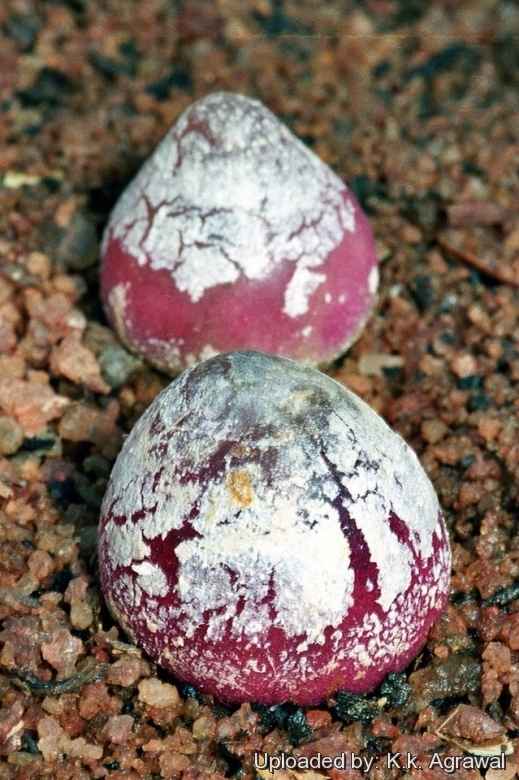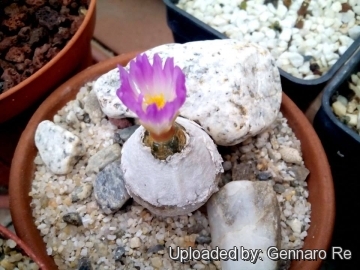




Your support is critical to our success.

Origin and Habitat: Conophytum burgeriSN|26040]]SN|26040]] has a very localized distribution around the mines near, Aggenys, between Sprinbok and Pofadder, Namaqualand, Nortern Cape, South Africa. The strewn valley in which it grows was that used to be the property of the Burger family (hence the name) but is now owned by the Black Mountain mine company who have protected it over the years.
Habitat and ecology: Conophytum burgeriSN|26040]]SN|26040]] grows in full sun in Succulent Karoo vegetation on firm rises where quartz-covered clayey soil occurs. Fewer than 250 plants occurring at a single site are potentially threatened by habitat loss, mining and illegal collecting (gathering) for the specialist succulent horticultural trade.
Synonyms:
- Conophytum burgeri L. Bolus
ENGLISH: Burger's onion, Little Light Bulbs
AFRIKAANS (Afrikaans): Papierkannetjie
RUSSIAN (Русский): Конофитум Бургера
Description: Conophytum burgeriSN|16149]]SN|26040]], sometimes referred to as 'Burger's Onion', is a small desert plant that looks like a strange 'strawaberry-coloured' onion and is the oddest member of the genus. It is very slow to clump up; four or five heads being the maximum normally seen in cultivation. Unlike many conophytums (e.g. Conophytum bilobumSN|1166]]SN|1166]] and Conophytum obcordellumSN|26040]]SN|16149]]) it is a spring and summer growing plant. During winter the plants are covered by a white sheath. Old plants can reach the size of a small chicken egg.
Bodies (paired leaves): Solitary, rarely doubled, but up to 5 headed in cultivation, not sunken. Leaves wholly fused 13-25(-30) mm tall, 20-25 (-30) mm in diameter at the base, broadly ovate or conical, flat toward the base and sometimes indented or scalloped around the base, translucent pale grey-green to rich ruby red, shiny, very smooth, covered with persistent white flaking sheaths. Fissure glabrous, short 2-4 mm long often inconspicuous.
Flower: Honey-scented purple-rose, long, often splitting the bodies. The calyx-tube is 4-5 mm long with 6 greenish-white sepals with thin margins. The corolla tube (10 mm long) is longer than the calyx tube. There are 24-52 petals (7-18 mm long, 3 mm wide) in a 2-3 series. The petals are rose-purplish in colour and white toward the base. The stamens occur in three series and there are numerous delicate whitish filaments (10 mm long), anthers are yellow. The stigmas (10-14 mm long) are free.
Blooming season: Early autumn (The flowering time in South Africa is April-May) Flowers are crepuscular and opening briefly in the mid afternoon.
Fruits: 6-locular, sharply pointed above.
Note: Uniquely in the genus, the cotyledon stage of C. burgeri closely resembles that of Dinteranthus.
Bibliography: Major references and further lectures
1) Heidrun E.K. Hartmann “Illustrated Handbook of Succulent Plants: Aizoaceae A-E” Springer, 2002
2) Hammer, S.A., Victor, J.E. & Raimondo, D. 2006. Conophytum burgeri L.Bolus. National Assessment: “Red List of South African Plants” version 2014.1. Accessed on 2014/07/13
3) Gideon Smith u.a. “Mesembs of the World: Illustrated Guide to a Remarkable Succulent Group.” Briza Publications, 1998
4) Werner Rauh “The Wonderful World of Succulents:Cultivation and Description of Selected Succulent Plants Other Than Cacti” Smithsonian Institution Press, 1984
5) James Cullen, Sabina G. Knees, H. Suzanne Cubey “The European Garden Flora Flowering Plants: A Manual for the Identification of Plants Cultivated in Europe, Both Out-of-Doors and Under Glass” Cambridge University Press, 11/ago/2011
6) Steven A. Hammer “Dumpling and his wife: new views of the genus Conophytum” EAE Creative Colour Ltd., 2002

Conophytum burgeri Photo by: Gennaro Re
The gallery now contains thousands of pictures, however it is possible to do even more. We are, of course, seeking photos of species not yet shown in the gallery but not only that, we are also looking for better pictures than those already present. Read More...
Cultivation and Propagation: Conophytum burgeriSN|26040]]SN|26040]] is easy to grow, but like most, it will split and crack if overwatered (unsightly but usually not fatal). These plants grow on spring and summer rain and head for winter dormancy. They like bright sun, cool nights, and plenty of fresh air.
Soil: It prefer a very porous potting mix to increase drainage. You can grow a plant in a 6-8 cm pot for years and have perfectly happy plants. For best results, use a shallow pot.
Repotting: Avoid to repot frequently. This plant may stay in the same pot for many years. Plants grown in larger containers have frequently relatively poor flowers. It might improve when the plants are given their own, small individual pots.
Watering: It requires little water; otherwise its epidermis breaks (resulting in unsightly scars, and are likely to rot). Water throughout the year although minimally in winter, (only when the plant starts shrivelling). For most cultivation situations, this means a light watering every week or so, when the soil is quite dry, during the spring-summer growing period, and nothing but a bit of mist during sunny weather in winter.
Fertilization: The plants are fertilized only once during the growing season with a balanced fertilizer diluted to ½ the recommended strength.
Exposure: Keep cool and shaded from hot sun in mid-summer; it needs full sun or light shade in the other seasons.
Hardiness: Hardy to -2°C. Ensure a very good ventilation.
Pest & diseases: Conophytums are sensitive to mealybugs.
Rot: Rot is only a minor problem with Conophytums if the plants are watered and “aired” correctly. If they are not, fungicides won't help all that much. Care must be given in watering, keeping them warm and wet while growing, and cooler and dry when dormant.
Propagation: It can be reproduced only by seed. The plants are very slow growing, even under ideal conditions, it will take three or four years to get a plant the diameter of a pea, but otherwise not difficult to cultivate. Sowing in early to late summer gives best results. Germination is quick and easy for seed sown on the surface of moist soil, but the minute seedlings have to be coddled along for their first year of life. Water when the medium is just barely dry, and spray lightly with dilute fertilizer every few weeks. Otherwise, seedlings and adult plants prefer similar conditions: bright sun, cool nights, and plenty of fresh air.
| Your Actions | |
|---|---|
| Back to Conophytum index | |
| Back to Aizoaceae index | |
 |
Back to Succulents Encyclopedia index |
Privacy stantement - Terms and conditions - How to cite - About us - Feedback - Donate



